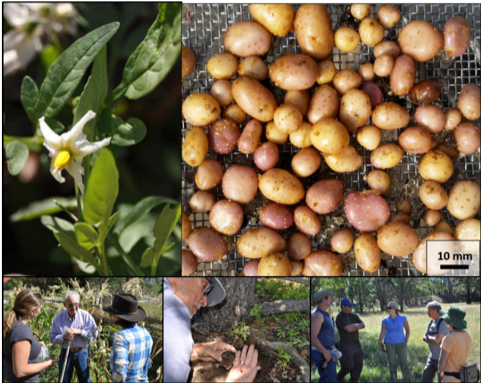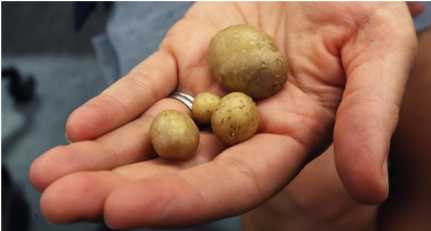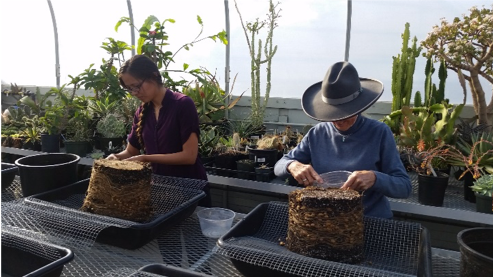Plant Domestication: Four Corners Potato
 How are wild plants transformed into crops? The process of domestication is essential
for producing nutritious foods that can be grown, harvested, stored and eaten. It
is an interactive process, with humans transporting and cultivating desirable species,
thus creating the base of the food chain and a great diversity of plant forms. The
common potato, for example, was domesticated over 7,000 years ago in the high Andes
and is now the third most important crop in the world, comprising over 4,500 varieties.
And although domestication has occurred and been studied in hundreds of species, only
a few plants native to North America were ever domesticated and none of those are
from west of the Mississippi.
How are wild plants transformed into crops? The process of domestication is essential
for producing nutritious foods that can be grown, harvested, stored and eaten. It
is an interactive process, with humans transporting and cultivating desirable species,
thus creating the base of the food chain and a great diversity of plant forms. The
common potato, for example, was domesticated over 7,000 years ago in the high Andes
and is now the third most important crop in the world, comprising over 4,500 varieties.
And although domestication has occurred and been studied in hundreds of species, only
a few plants native to North America were ever domesticated and none of those are
from west of the Mississippi.
Recent evidence, however, suggests that a novel potato species, known as the Four
Corners Potato (Solanum jamesii) was manipulated by ancient people sometime during the last 12,000 years. The tubers
are an important food and energy source because of their nutritional qualities, reliable
productivity and ability to persist in the soil. Furthermore, populations of this
species now occupy atypical habitats among and within the great  pueblos of the Southwest, evidence that indigenous farming practices included this
species. Therefore, a collaborative archaeological, biological and traditional
pueblos of the Southwest, evidence that indigenous farming practices included this
species. Therefore, a collaborative archaeological, biological and traditional  ecological approach is well-suited to provide insight on the initial stages (use,
transport and manipulation) in the domestication process. In the broader context,
detecting these stages will challenge our understanding of foraging strategies and
a long-established scientific paradigm regarding agricultural origins and food choices
among hunter-gatherers in North America by identifying the Four Corners as a hitherto
unknown center of plant domestication. There are no other places in North America
that can claim such a long heritage with a local food.
ecological approach is well-suited to provide insight on the initial stages (use,
transport and manipulation) in the domestication process. In the broader context,
detecting these stages will challenge our understanding of foraging strategies and
a long-established scientific paradigm regarding agricultural origins and food choices
among hunter-gatherers in North America by identifying the Four Corners as a hitherto
unknown center of plant domestication. There are no other places in North America
that can claim such a long heritage with a local food.
Genetic Analyses
We collected DNA samples from 682 individual plants across 25 populations of the Four Corner potato—14 populations were near archaeological sites, while 11 were from non-archaeological areas in its natural distribution. The results showed that the most genetically diverse populations of S. jamesii were concentrated around the Mogollon Rim. Conversely, populations from archaeological sites exhibited reduced genetic diversity because the transported tubers may have only contained a fraction of the available genes (Pavlik et al. 2024).
We also found that populations of S. jamesii in Escalante Valley in Southern Utah have two different origins—one directly from the Mogollon Rim region and one related to Bears Ears, Mesa Verde and El Morro. These archaeological sites form a genetic corridor suggesting ancient people transported the tubers north south to north transport of tubers.
Despite being close geographically, four archaeological populations around Escalante Valley show distinct origins. The genetic signatures could indicate that people transported potatoes to new locations multiple times in the distant past in a pattern likely corresponding to ancient trade routes. We interpret the transport of the Four Corners potato as early stages of domestication, however, we plan to analyze specific gene sequences to learn more about S. jamesii.

Map showing genetic structure by ancestry. Each bar represents the genetic composition of a given potato population and shows where the genes came from. Pavlik et al. (2024), Am. J. Botany.
